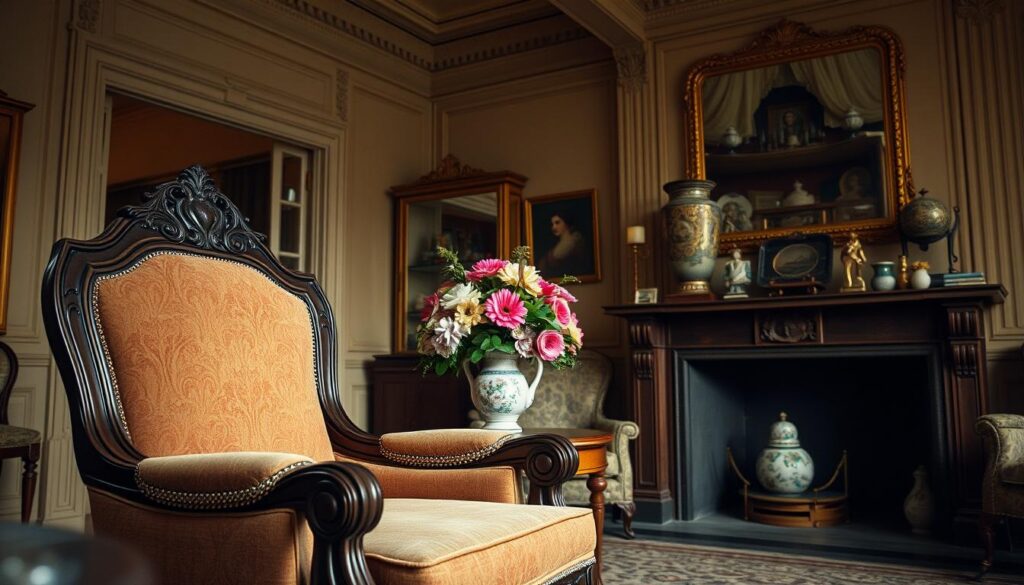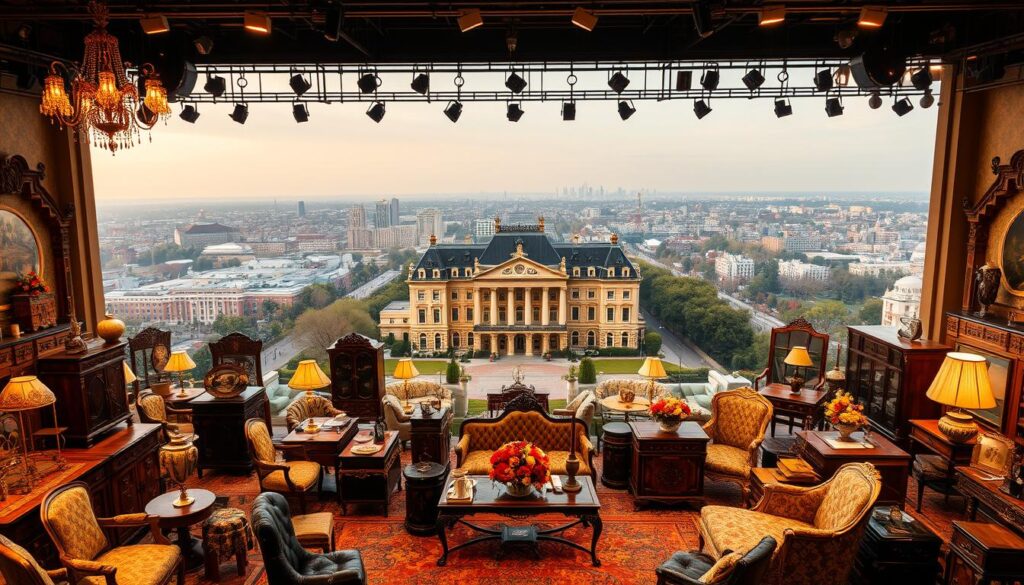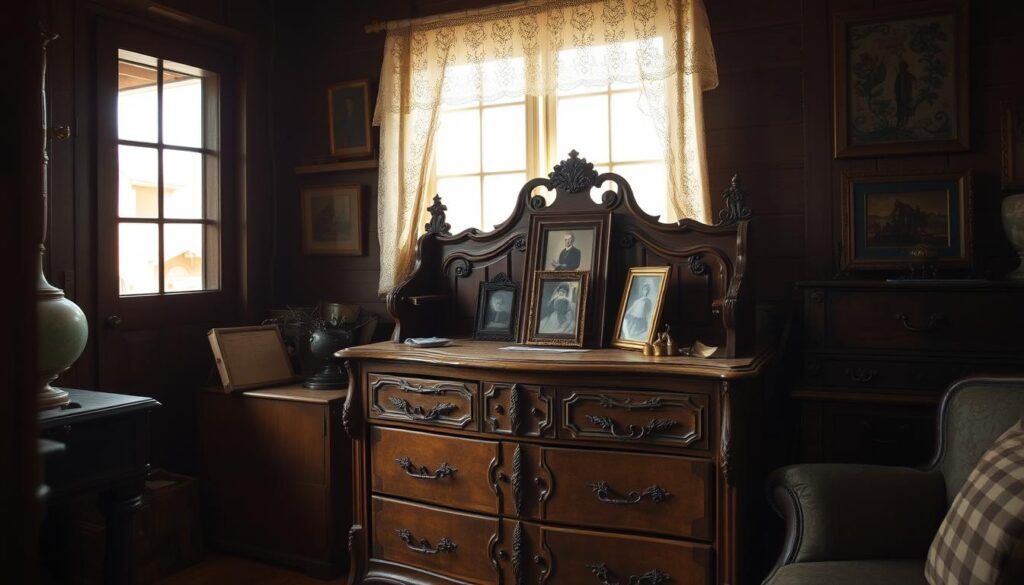In With the Old, Out With the New – this mantra is at the heart of vintage interior design. It’s about embracing the charm of bygone eras and incorporating it into our living spaces. Welcome a Blast From the Past into your home by reviving classic elements that never go out of style.

Vintage interior design is characterized by its timeless charm and unique character. It’s a style that celebrates the beauty of aged furniture, rich textiles, and ornate details. In this article, we’ll explore the 5 classic features that define vintage interior design and how you can incorporate them into your home decor.
Key Takeaways
- Understanding the essence of vintage interior design
- Identifying the 5 classic features of vintage style
- Learning how to incorporate vintage elements into modern decor
- Discovering the importance of timeless charm in home design
- Exploring ways to add unique character to your living space
The Charm of Vintage Interior Design
There’s something undeniably captivating about vintage interior design, with its rich textures and timeless appeal. It’s a style that effortlessly combines the old with the new, creating a unique and inviting atmosphere in any home.
Vintage interior design is characterized by its use of antique furniture, rich fabrics, and ornate architectural elements. These elements not only add character to a room but also tell a story of the past, making your space truly special.

In With the Old, Out With the New
Embracing vintage interior design means saying goodbye to the bland and hello to the beautifully aged. It’s about incorporating pieces that have a history, like antique furniture, into your decor.
For instance, a vintage armchair can become a statement piece in your living room, adding a touch of elegance and sophistication. The key is to balance old pieces with modern elements to avoid a cluttered look.
“The older the furniture, the more character it has.” –
Interior Designer
Welcoming a Blast From the Past
Vintage interior design is also about welcoming a blast from the past into your home. It’s about finding those unique, one-of-a-kind pieces that reflect your personality and style.
| Vintage Element | Modern Twist |
|---|---|
| Antique Furniture | Reupholstered with modern fabric |
| Rich Fabrics | Used as throw pillows or drapes |
| Ornate Lighting | Paired with modern minimalist fixtures |
By combining vintage charm with modern sensibilities, you can create a space that is both nostalgic and contemporary.
Understanding Vintage Design Eras
Understanding the different eras of vintage design is crucial for appreciating the complexity and beauty of vintage interiors. Each era brings its unique style and historical context, shaping the aesthetic of homes and public spaces.
Victorian and Art Nouveau
The Victorian era, named after Queen Victoria, is characterized by ornate furnishings, rich colors, and intricate patterns. Art Nouveau, on the other hand, emerged as a response to the industrial age, featuring sinuous, organic lines and a focus on decoration. Flowing curves and natural motifs define this style, which was popular in the late 19th and early 20th centuries.
Art Deco and Hollywood Regency
Art Deco celebrated the modernity of the early 20th century with geometric shapes, metallic materials, and bold colors. It was a glamorous style that influenced architecture, furniture, and decorative arts. Hollywood Regency, emerging later, continued the luxurious feel with a focus on bold colors, metallic accents, and exotic motifs, often used in the decor of old Hollywood homes.
Mid-Century Modern and Retro
Mid-Century Modern design is known for its simplicity, functionality, and integration with nature. It features clean lines, organic shapes, and a minimalist aesthetic. Retro style, while often associated with Mid-Century Modern, refers to the broader nostalgic revival of mid-20th-century styles, including bold colors and playful patterns.
| Era | Characteristics | Notable Features |
|---|---|---|
| Victorian | Ornate, rich colors | Intricate patterns, heavy furnishings |
| Art Nouveau | Organic lines, flowing curves | Natural motifs, decorative arts |
| Art Deco | Geometric shapes, metallic materials | Bold colors, luxurious feel |
| Mid-Century Modern | Simple, functional, natural integration | Clean lines, organic shapes |

By understanding these distinct eras, one can better appreciate the nuances of vintage interior design and how different styles can be blended or highlighted to create unique and captivating spaces.
Feature1: Antique Furniture with Character
Antique furniture is the cornerstone of vintage interior design, bringing character and history into our homes. When done correctly, incorporating antique pieces can elevate the aesthetic of a room, making it truly unique.
Identifying Quality Vintage Pieces
To start, it’s essential to know how to identify quality vintage furniture. This involves examining the construction, materials, and detailing of the piece.
Wood Types and Craftsmanship
The type of wood used and the craftsmanship are critical indicators of a piece’s quality. Solid hardwoods like oak, walnut, and mahogany are often preferred for their durability and beauty. Look for signs of handcraftsmanship, such as dovetail joints and hand-carved details, which signify a piece’s age and value.
Hardware and Detailing
Hardware and detailing can also reveal a lot about a vintage piece. Ornate metalwork, intricate carvings, and high-quality finishes are hallmarks of well-made antique furniture. Inspect the hardware for signs of wear and authenticity, as these elements can significantly impact the piece’s overall character.
Incorporating Statement Furniture
Once you’ve identified quality vintage pieces, the next step is incorporating them into your decor. Statement furniture can serve as a focal point in a room, drawing the eye and sparking conversation. Consider placing a vintage armchair in a bold color or a intricately carved wooden cabinet in a prominent location to add visual interest.

Restoration vs. Preservation
When it comes to antique furniture, owners often face the dilemma of whether to restore or preserve their pieces. Restoration involves repairing and renewing the furniture to its original condition, while preservation focuses on maintaining the piece in its current state, with minimal intervention. The choice between the two depends on the item’s historical significance, condition, and intended use.
Feature2: Rich, Textured Fabrics and Textiles
In vintage interior design, rich, textured fabrics and textiles are not just decorative elements, but they also tell a story of the past. These materials add a layer of depth and character to a room, making it feel more inviting and cozy.
Velvet, Brocade, and Damask
Velvet, brocade, and damask are some of the most luxurious fabrics associated with vintage design. Velvet is known for its soft, plush pile, while brocade is recognized by its intricate, woven patterns. Damask, on the other hand, is a reversible fabric with a woven design. These fabrics are often used in upholstery, drapery, and even wall coverings to add a touch of opulence to a room.
“The use of luxurious fabrics like velvet and brocade can instantly elevate the ambiance of a room, making it feel more sophisticated and refined.”
Vintage Patterns and Prints
Vintage patterns and prints are another key element of vintage textiles. These patterns can range from classic florals to geometric motifs, each with its own unique charm.
Floral and Botanical Designs
Floral and botanical designs are a staple of vintage textiles. These patterns often feature intricate, hand-drawn illustrations of flowers and foliage, adding a touch of elegance to any room.
Geometric and Abstract Motifs
Geometric and abstract motifs are also common in vintage textiles. These patterns can add a modern twist to a vintage space, creating a unique and interesting contrast.
| Fabric Type | Characteristics | Common Uses |
|---|---|---|
| Velvet | Soft, plush pile | Upholstery, drapery |
| Brocade | Intricate, woven patterns | Upholstery, wall coverings |
| Damask | Reversible, woven design | Drapery, tablecloths |
Incorporating Vintage Textiles
Incorporating vintage textiles into your decor can be as simple as adding a vintage throw blanket or pillow cover to a room. You can also use vintage fabrics to reupholster furniture or create new drapery. The key is to balance vintage elements with modern pieces to avoid overwhelming the space.
By incorporating rich, textured fabrics and textiles into your vintage interior design, you can create a space that is both elegant and inviting.
Feature3: Ornate Architectural Elements
Ornate architectural elements, such as crown moldings and wainscoting, are essential features of vintage interior design. These elements not only add visual interest but also bring a sense of history and sophistication to a room.
Crown Moldings and Ceiling Medallions
Crown moldings and ceiling medallions are classic examples of ornate architectural elements. Crown moldings add a touch of elegance to rooms by creating a seamless transition between walls and ceilings. Ceiling medallions, often intricately designed, serve as a beautiful centerpiece around light fixtures or ceiling fans.
To incorporate these elements into your vintage interior design, consider the following:
- Choose crown moldings that complement the room’s style and scale.
- Select ceiling medallions that match the intricacy of other design elements in the room.
Wainscoting and Panel Molding
Wainscoting and panel molding are other ornate architectural elements that can enhance the vintage charm of a room. Wainscoting involves applying wooden panels to the lower portion of walls, while panel molding refers to the decorative frames used on walls and doors.
| Type | Description | Design Considerations |
|---|---|---|
| Wainscoting | Wooden panels on lower walls | Material, height, and design |
| Panel Molding | Decorative frames on walls and doors | Style, material, and color |
Adding Architectural Details to Modern Homes
Incorporating ornate architectural elements into modern homes can be challenging, but it’s achievable with the right approach. Consider using a mix of original and reproduction elements to create an authentic vintage look.
“The key to successfully integrating vintage elements into modern design is balance. Too many ornate details can overwhelm a space, while too few may not make enough of a statement.”
By thoughtfully incorporating ornate architectural elements, you can add depth and character to your interior design, blending the best of vintage charm with modern functionality.
Feature4: Classic Vintage Lighting
The charm of classic vintage lighting lies in its ability to add character and sophistication to any room. Lighting fixtures are not just functional elements; they are also decorative pieces that can significantly impact the ambiance of a space.
Chandeliers and Pendant Lights
Chandeliers and pendant lights are statement pieces that can instantly elevate the elegance of a room. Chandeliers, with their multiple arms and ornate details, are perfect for dining rooms and entryways, while pendant lights offer a more streamlined look, ideal for kitchens and living areas.
When selecting vintage chandeliers or pendant lights, consider the scale and proportion of the fixture in relation to the room and its furniture. A large, ornate chandelier can be a focal point in a spacious dining room, whereas a smaller, more delicate pendant light can add a touch of elegance to a cozy reading nook.
Wall Sconces and Table Lamps
Wall sconces and table lamps are versatile lighting options that can add warmth and depth to a room. Wall sconces are ideal for creating a soft, ambient glow in hallways and bedrooms, while table lamps can provide task lighting on bedside tables or desks.
Vintage wall sconces and table lamps often feature intricate designs and ornate details, making them not just sources of light but also decorative pieces that can enhance the vintage aesthetic of a room.
Modernizing Vintage Lighting Fixtures
To modernize vintage lighting fixtures, consider updating the wiring and adding new shades or diffusers. This can not only improve the functionality of the fixture but also refresh its appearance to fit contemporary decor.
| Modernization Tip | Description | Benefit |
|---|---|---|
| Update Wiring | Replace old wiring with new, safety-certified components. | Improved safety and efficiency |
| Add New Shades | Install modern shades or diffusers to change the light’s color and diffusion. | Enhanced aesthetic appeal |
| Refinish or Repaint | Refinish or repaint the fixture to match modern decor. | Seamless integration with contemporary design |
By thoughtfully incorporating classic vintage lighting into your interior design, you can create a space that is both elegantly nostalgic and stylishly contemporary.
Feature5: Authentic Color Palettes and Finishes
Creating a vintage-inspired room requires a deep understanding of authentic color palettes and their role in interior design. The right color palette can evoke a sense of nostalgia and character, defining the aesthetic of a vintage space.
Muted Tones and Heritage Colors
Muted tones and heritage colors are fundamental to vintage interior design. These colors, often derived from natural dyes, bring warmth and depth to a room. Earthy tones such as ochre, sienna, and moss green are examples of heritage colors that can be used to create a cohesive vintage look.
Earthy tones like ochre and sienna are not only aesthetically pleasing but also add a layer of historical authenticity to a room.
Rich Jewel Tones and Metallics
In contrast to muted tones, rich jewel tones and metallics can add a touch of luxury and opulence to vintage interiors. Colors like emerald green, sapphire blue, and ruby red, when used appropriately, can create dramatic focal points. Metallics such as gold, brass, and bronze further enhance the richness of a vintage space.
“The use of rich jewel tones and metallics can elevate a vintage interior from simple to sophisticated.”
These elements, when balanced correctly, contribute to a visually appealing and authentic vintage design.
Wallpapers and Decorative Finishes
Wallpapers and decorative finishes play a crucial role in completing the vintage look. Traditional wallpapers with intricate patterns and designs can add texture and visual interest. Decorative finishes such as distressed wood, marbled surfaces, and gilded details further enhance the authenticity of a vintage-inspired room.
By incorporating these elements, homeowners can achieve a vintage aesthetic that is both charming and sophisticated.
Sourcing and Collecting for Your Vintage Interior Design
To infuse your home with vintage charm, you need to know the best sources for vintage items. Sourcing vintage pieces can be a rewarding experience, allowing you to uncover unique elements that add character to your interior design.
One of the joys of vintage interior design is the hunt for authentic pieces. Whether you’re a seasoned collector or just starting out, there are several avenues to explore.
Antique Stores and Estate Sales
Antique stores and estate sales are treasure troves for vintage enthusiasts. These venues offer a wide range of items, from antique furniture to vintage accessories. When shopping at antique stores, look for pieces with provenance or historical significance. Estate sales, on the other hand, can yield surprising finds, as entire households are often sold off at once.
Tips for Shopping at Antique Stores and Estate Sales:
- Research beforehand to understand the market value of items you’re interested in.
- Inspect items carefully for condition and authenticity.
- Be prepared to negotiate prices.
Online Marketplaces and Auctions
The digital age has made it easier than ever to source vintage pieces. Online marketplaces like eBay, Etsy, and Ruby Lane offer a vast array of vintage items. Online auctions can be particularly exciting, as you can bid on rare or unique pieces.
When shopping online, ensure you’re buying from reputable sellers. Check seller ratings, read reviews, and carefully review item descriptions to avoid misunderstandings.
| Platform | Specialty | Tips |
|---|---|---|
| eBay | Varied vintage items | Use specific keywords to find what you’re looking for. |
| Etsy | Handmade and vintage items | Filter by price, location, and more to narrow your search. |
| Ruby Lane | Antique and vintage items | Browse by category or shop specific stores. |
Reproduction vs. Authentic Pieces
When sourcing vintage items, one crucial decision is whether to opt for authentic vintage pieces or reproductions. Authentic pieces offer historical value and unique character, while reproductions can be more affordable and still capture the essence of a bygone era.
Consider the following when deciding between authentic and reproduction pieces:
- Budget: Authentic vintage pieces can be expensive.
- Usage: High-traffic areas might benefit from more durable reproductions.
- Aesthetic: Authentic pieces can add significant character, but reproductions can still offer the desired vintage look.
Conclusion
Vintage interior design is more than just a style; it’s a way to infuse your home with character and personality. By incorporating classic features such as antique furniture, rich textiles, and ornate architectural elements, you can create a space that exudes warmth and sophistication.
The key to successfully integrating vintage interior design into your home is to strike a balance between old and new. Pairing vintage pieces with modern elements can create a unique and captivating aesthetic. Whether you’re drawn to the elegance of Victorian-era design or the glamour of Art Deco, there’s a vintage style to suit every taste.
As you’ve seen throughout this article, vintage interior design encompasses a range of classic features that can add timeless charm to your home. By understanding the different design eras and incorporating vintage elements in a thoughtful and intentional way, you can create a space that feels both nostalgic and modern. So why not start exploring the world of vintage interior design and discover the beauty of timeless charm for yourself?
FAQ
What is vintage interior design?
Vintage interior design is a style that incorporates elements from past eras, such as antique furniture, rich textiles, and ornate architectural details, to create a unique and charming atmosphere.
How do I incorporate vintage pieces into my modern home?
You can start by adding one or two vintage statement pieces, such as a vintage armchair or a vintage rug, to your existing decor. You can also mix vintage and modern elements to create a unique and interesting contrast.
What are some popular vintage design eras?
Some popular vintage design eras include Victorian, Art Nouveau, Art Deco, Mid-Century Modern, and Retro. Each era has its own distinct characteristics and styles.
How do I identify high-quality vintage furniture?
Look for pieces made from solid wood, such as oak or walnut, and check for signs of craftsmanship, such as intricate carvings or dovetail joints. You should also inspect the hardware and detailing, such as hinges and handles.
Can I restore or refinish vintage furniture?
Yes, you can restore or refinish vintage furniture to give it a new life. However, it’s essential to preserve the original character and integrity of the piece. Consider seeking professional help if you’re unsure.
Where can I find vintage pieces for my interior design?
You can find vintage pieces at antique stores, estate sales, online marketplaces, and auctions. Be sure to research and inspect the pieces carefully to ensure their authenticity and quality.
How do I mix vintage and modern lighting fixtures?
You can mix vintage and modern lighting fixtures by using vintage fixtures as statement pieces and supplementing them with modern fixtures to create a layered and interesting lighting scheme.
What are some common vintage color palettes?
Common vintage color palettes include muted tones, such as beige and mauve, and rich jewel tones, such as emerald green and navy blue. You can also consider using heritage colors, such as terracotta and golden brown.
Can I use wallpaper in a vintage-inspired room?
Yes, wallpaper can be a great way to add a vintage touch to a room. Consider using vintage-inspired patterns, such as florals or stripes, or opting for a vintage-style wallpaper with a distressed or textured finish.
